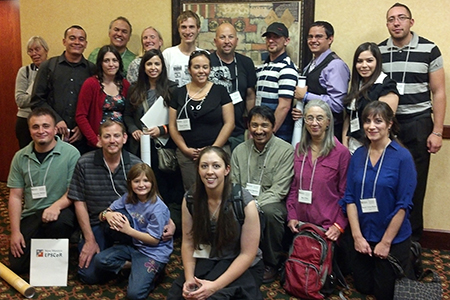
Nearly 30 Highlands science faculty and students participated in the NMAS and New Mexico EPSCoR annual symposium, including front row from left, natural resource management graduate students Sebastian Medina and Robert Ortega (with daughter Robyn), and biology graduate student Molly Wright, natural resource management professor Edward Martinez, and biology professors Mary Shaw and Sarah Corey-Rivas. From left in the second row are natural resource management graduate student Benjamin Gonzales, Luna EPSCoR intern Kodie Lynn Martinez, forestry senior Rose Peralta, and natural resource management graduate student Elyssa Duran. From left in the third row are chemistry professor Tatiana Timofeeva, biology professor Jesíºs Rivas, forestry professor Sara Brown, biology junior Nick Lormand, Rick McNeill, N.M. Forest and Watershed Restoration Institute, forestry senior Clint West, chemistry graduate student Carlos Ordoñez, natural resource management graduate student Felicia Archuleta, and biology senior Justin Saiz.
Las Vegas, N.M. — New Mexico Highlands University science students made a strong showing at the New Mexico Academy of Science and New Mexico EPSCoR annual symposium, presenting more research studies than any other university in the state for the second year in a row.
The Highlands University science faculty and students presented 12 of the 24 oral research presentations and 12 of 27 research posters Nov. 9 in Albuquerque at the symposium.
New Mexico EPSCoR — Experimental Program to Stimulate Research – is a National Science Foundation funded collaborative research initiative that has worked since 2009 to build the state’s capacity to conduct scientific research.
“Highlands is stepping forward and making great advancements in involving a growing number of undergraduate and graduate students in interdisciplinary science research,” said Mary Jo Daniel, associate director for New Mexico EPSCoR. “The quality of the students’ research is consistently high and is making important contributions to understanding climate change impacts in New Mexico on water, the environment, and wildlife.
“I’m very impressed with the Highlands science faculty, including the energy, expertise and commitment they demonstrate in providing research opportunities for their students,” Daniel said.
She added that the Highlands University students’ research is on par with their peers at the big research institutions in the state.
The University of New Mexico, New Mexico State University, and New Mexico Tech also participated in the symposium.
“The majority of the Highlands research presented at EPSCoR focuses on the restoration and management of our natural resources — such as endangered species, wildlife, forests, water and soil — through the disciplines of biology, forestry and geology,” said natural resource management professor Edward Martinez.
In 2009, Highlands University was awarded a five-year $631,548 New Mexico EPSCoR grant and Martinez is the principal investigator. Since then, Highlands was awarded three $50,000 EPSCoR seed grants to fund pilot studies aimed at targeting large federal grants to fund ongoing and future research.
Since 2009, more than 40 Highlands University students have participated in EPSCoR-funded research.
“The EPSCoR grants have built research capacity at Highlands by funding field and lab equipment purchases, and funding students to conduct research,” Martinez said, noting that the five-year grant ended in August.
Other Highlands science professors who advised students on their EPSCoR research include biology professors Jesíºs Rivas and Sarah Corey-Rivas, forestry professor Sara Brown, geology professors Jennifer Lindline and Michael Petronis, and chemistry professor Tatiana Timofeeva.
“We have benefited greatly from EPSCoR’s financial support, as well as the opportunity to network and collaborate on research,” Corey-Rivas said.
The faculty and students did research on diverse topics like bison genetics, aquatic toxicology, wildfire burn severity, invasive species, urban wildlife, juniper ecology, chemical nano-particle technology, black-tailed prairie dogs, and much more.
“Our students have the opportunity to do fieldwork in a variety of diverse ecosystems ranging from the Kiowa grasslands near Clayton to the Valles Caldera National Preserve in the Jemez Mountains,” Brown said.
Elyssa Duran, a natural resource management graduate student from Cuba, N.M., did a study analyzing soil across burn severity areas from the catastrophic 2011 Las Conchas Fire in the Valles Caldera National Preserve.
Martinez and Brown were Duran’s research advisers. Natural resource management graduate student Anita Lavadie, who presented her thesis on hydrological and soil nutrient impacts of the Las Conchas Fire, mentored Duran.
“We investigated how wildfire impacts nitrogen in the soil,” Duran said. “The findings suggest that with high severity fire, nitrogen is removed from the soil, leading to difficulties in plant regeneration.”
Duran earned her B.S. in forestry and Spanish at Highlands, saying her science research opportunities have been outstanding.
Robert Ortega, a natural resource management graduate student from Mora, N.M., presented his thesis study on the impact invasive bullfrogs have on the demographics of the northern leopard frogs native to New Mexico. Rivas is his adviser.
“Invasive species like bullfrogs can alter the dynamics of a riparian ecosystem like the Mora River at the new national wildlife refuge,” Ortega said. “We removed bullfrogs from a 2.4 kilometer section of the river. Within a year, there was an increase in juvenile leopard frogs in our experimental zone.”
Ortega earned his B.S. in biology from Highlands.
“My fieldwork research experience at Highlands has been amazing. You get to apply the concepts you learn in class, and go beyond theory to practice,” Ortega said.
“Involving the students in hands-on research is one of the ways we are more effective teachers,” Rivas said. “We are building future scientists through these kind of field-based research opportunities that incorporate lab analysis.”
A complete listing of the Highlands faculty and student research presented at the NMAS and New Mexico EPSCoR symposium is online.
